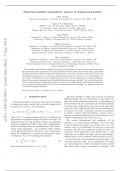Tentamen (uitwerkingen)
Numerical analytic continuation: answers to well-posed questions
- Vak
- Instelling
data are processed by making certain assumptions about the underlying function. This motivates an alternative formulation of the NAC goal involving integrals of A(z) that render the problem well-defined. With additional assumptions about the smoothness and other properties of A(z) behind these...
[Meer zien]



